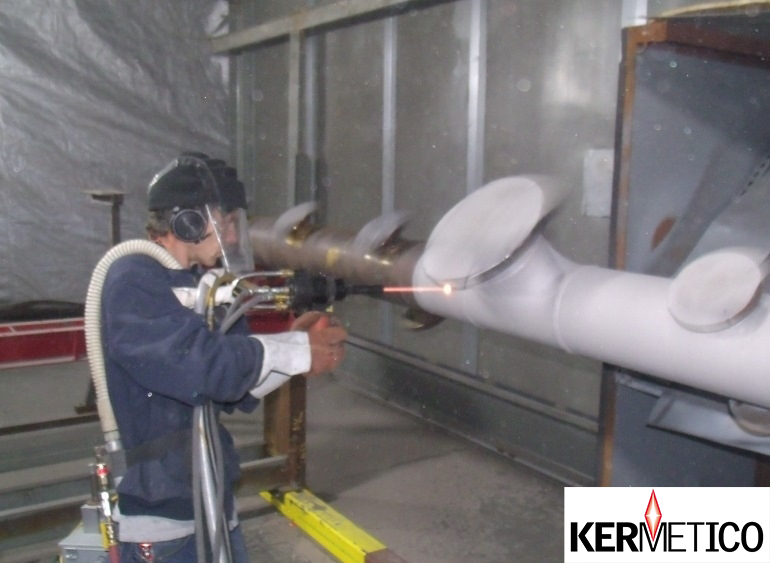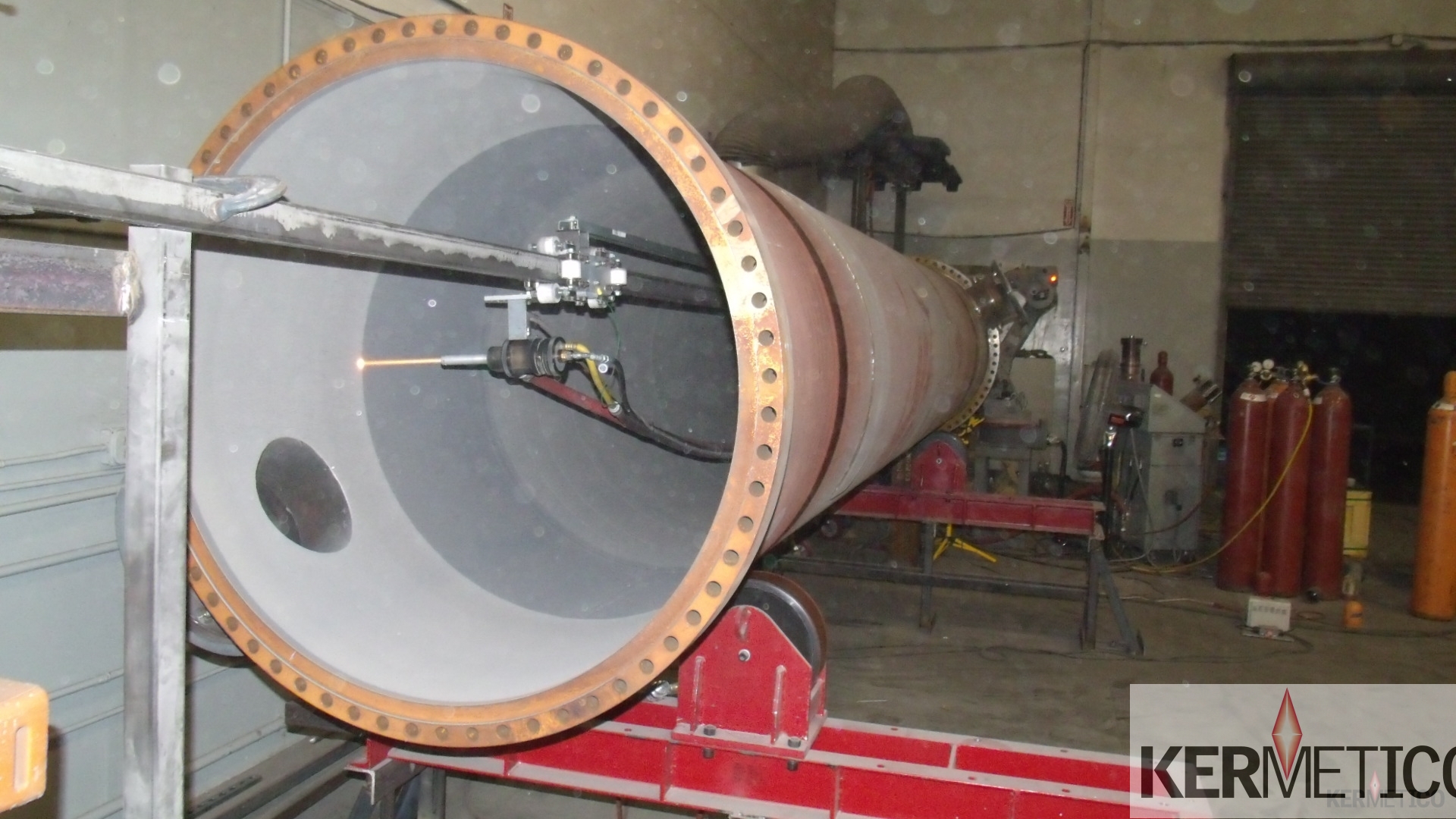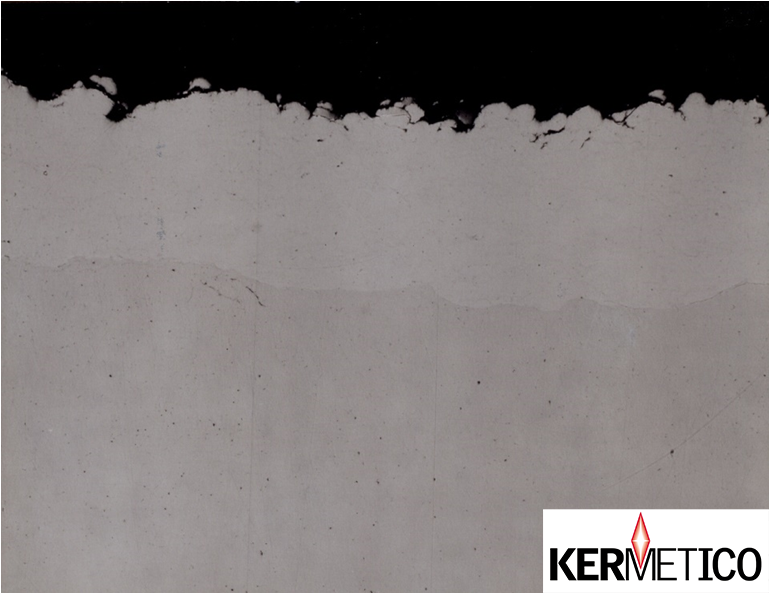A refinery sulfur recovery plant operates multiple pressure vessels exposed to H₂S and CO₂ corrosion due to the presence of hydrogen sulfide and carbon dioxide containing fumes and moisture in varying temperature conditions. Categorized as pressure vessels, the towers, absorbers, condensers and channels are frequently made of mild carbon steel with low corrosion resistance.
Kermetico HVAF thermal spray equipment and technology allows depositing dense metal H₂S resistant coating to mitigate H2S and CO2 corrosion of pressure vessels and piping.
Coatings Protecting Refinery Pressure Vessels from H2S Hydrogen Sulfide Stress Cracking (SSC)
There is a need to extract hydrogen sulfide from oil and gas in petrochemical processing.
H2S corrosion, or sour corrosion, occurs when H2S gas reacts with carbon steel in a wet and sour environment.
In the case of sour corrosion, hydrogen atoms formed during the corrosion process at the metal surface diffuse through the surface of the carbon steel and become trapped at laminations caused by voids and nonmetallic inclusions.
When atomic hydrogen is absorbed by solid metals, hydrogen-induced cracking (HIC) can result. The hydrogen atoms combine to form molecular hydrogen (H2), which creates pressure from within the metal.
Trapped H2 gathers at these locations and forms blisters as pressure builds. Eventually, cracking occurs when several hydrogen blisters connect in the base metal.
Several mitigation methods are known to prevent sulfide stress cracking and hydrogen induced corrosion. One is to perform a stress-relieving treatment on the metal to reduce hardness levels to acceptable levels in an annealed microstructure. A second method is to clad the carbon steel linings and welds with a corrosion-resistant alloy.
Cladding the interior of a treatment column with a thermal spray-applied corrosion resistant alloy would form a barrier between the carbon steel and the sour process fluid and prevent sour corrosion, which would stop the formation of hydrogen atoms and their subsequent migration into the steel.
Unlike a sacrificial thermal spray coating that is designed to corrode preferentially to protect the substrate, a barrier thermal spray coating for this application needs to completely block the fluid’s corrosive constituents from rusting the base metal, so porosity and density of the applied coating are important considerations for preventing corrosion of the substrate.
Kermetico HVAF thermal spraying is an industrial coating process that uses a chemical (flame) heat source to preheat a powder coating material and spray it onto surfaces.
Depending on the corrosion activity of the environment and the planned equipment life-cycle, different HVAF coatings could be applied onto the surface from stainless steel to Hastelloy-type.
A Case of a Petrochemical Refinery Sulfur Condenser Sour Gas Corrosion
Mild steel petrochemical equipment treating sour components is subject to severe H2S and SO2 corrosion.
The sulfur condenser outlet channel suffers extensive pitting due to dew point corrosion caused by condensation of sulfuric acid on the “cold spots” where the metal surface temperature drops below 120°C (248°F).
After successful testing in boiling concentrated sulfuric acid media the Hastelloy – type Kermetico HVAF coating of 0.25 mm (0.010”) thickness was specified for application on the complete inner surface of the outlet channel (1.8 m (6’) diameter, 2.7 m (9’) long), with a gas outlet (0.76 m (2.5’) diameter, 0.3 m (1’) long) welded to it as well as on the channel cover (1.8 m diameter).
We have robotically HVAF grit blasted the inner surface of the channel with the AK7 system, and have robotically applied the coating everywhere except for the masked areas for welding of the demister frame and plates.
Following the welding of the de-mister support structure, we sprayed the welds with the manual Kermetico HVAF AK-HH gun.
After installation of the channel at the plant, the customer flame-cut a hole in the bottom through the coating and welded the liquid sulfur outlet to it.
Finally, the corrosion resistant coating was applied over the cut area and inside the liquid sulfur outlet with a hand-held AK-HH gun on-site.
After five years in operation, the H2S resistant coatings on the channel and cover are intact and remain in service.

Spraying a Hastelloy C-type coating onto a Manifold with the Kermetico HVAF AK-HH Handheld Gun
Depositing Alloyed HVAF Coatings onto Complex Surfaces of Manifolds
The Kermetico HVAF AK system may operate several thermal spray guns with different designations:
- AK5 – a compact spray gun to efficiently deposit h2s resistant coating onto internal surfaces of vessels and complex geometries.
- AK-ID – a gun to spray inside diameters 88 mm (3.47”) and larger
- AK-IDR– a rotating gun to spray barrels 100 mm (4”) and larger and up to 600 mm (2’) deep
- AK-HH – a manual HVAF gun to spray on-site or onto complex surfaces like manifolds
The high energy efficiency and relatively low output of the Kermetico HVAF systems minimize the heat load into the vessel surface, allowing spraying faster and with lower ventilation requirements to maintain an ideal application temperature without overheating the part.
The Quality of the Kermetico HVAF Corrosion Protective Vessel Coating
The combustion temperature in air-fuel mixtures is typically 1,960-2,010°C (3,560-3,650°F) which is about 1,000°C (1,832°F) lower than in oxygen-fuel combustion.
This lower temperature is ideal for the gradual heating of the feedstock particles of alloyed metals to or slightly above the metals’ melting temperature.
The initial oxygen content in the combustion gas mixture is 5-fold lower in the HVAF process compared to any HVOF process. Both factors prevent the oxidation of metals and the decomposition of carbides and their dissolution into the metal binder.
These factors allow the retention of the original ductility of the powder feedstock material in the applied coating, even when the hardness of the cemented carbide coating exceeds 1,600 HV300.
A Typical Cross-Sectional Micrograph of a Kermetico HVAF H2S Resistant Coating
Blast and Spray with Kermetico High Velocity Equipment
Usually, we deposit the vessel coating using robotic HVAF blast and spray operations.
We blast a vessel surface with the Kermetico HVAF gun (it is extremely fast and uniform) and spray with the same gun after switching the powder feed hose and perhaps changing the nozzle
It is much faster, more accurate and needs much less grit than manual blasting.
It also provides very even surface preparation and induces less stress into the base metal.
Auxiliary equipment:
- A Grit Feeder for the grit blast preparation of parts to reduce coating cost
- A Gas Permeability Tester for an instant check of a coating’s through porosity
Kermetico, Inc. – Material Science Excellence, HVAF and HVOF Equipment Manufacturing and Thermal Spray Coating Services Since 2006
We create equipment that helps material scientists, engineers and business managers achieve their goals.
We have installed more than 60 Kermetico HVAF and HVOF systems in the USA, Europe, Japan and China.
Some of the systems are at work in Universities and National Labs, but most of them are used in production thermal spray shops.
We proudly design and produce our thermal spray equipment in California and install it all over the world.
You can visit our R&D center in Benicia to meet our designers and see our HVAF equipment in action.
We also service the U.S. customers with HVAF and HVOF thermal spray coatings – ourselves and through the network of our partners.





















